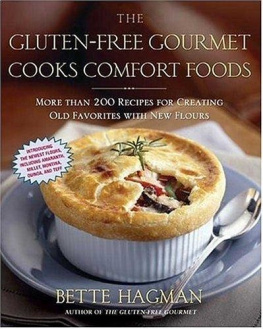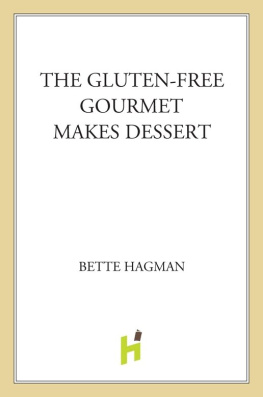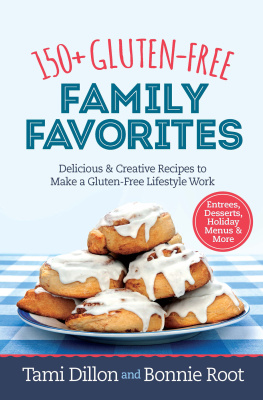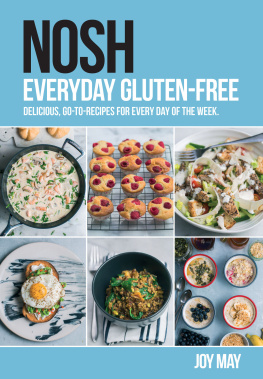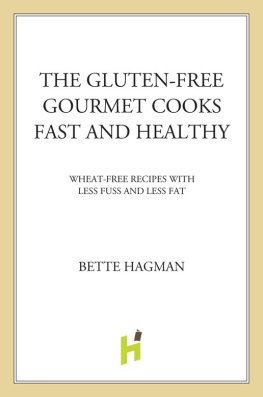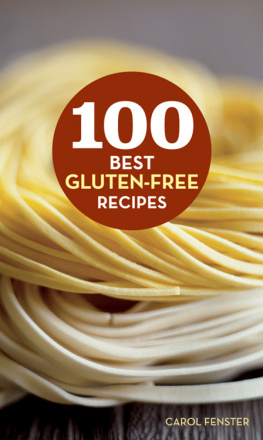This book is dedicated to the memory of three friends, pioneers in celiac awareness when it was still considered a rare disease: Pat Garst, author of some of the first laymans writings about the disease; Elaine Hartsook, founder of the Gluten Intolerance Group; and Mary Alice Warren, who took celiacs on the first gluten-free cruises.
C eliac disease is a syndrome characterized by damage to the lining of the small intestine, caused by the gluten in wheat and similar proteins of barley and rye. The presence of gluten in people with celiac disease leads to mucosal damage, while the elimination of gluten results in full recovery for the patient. In the continued presence of gluten, the disease is self-perpetuating. It is the interplay between genes and environment (gluten) that leads to the intestinal damage typical of the disease.
Celiac disease is one of the most common lifelong disorders in Europe and in the United States. This condition can be found in patients with a range of symptoms, including chronic diarrhea, weight loss, and abdominal distention or a range of symptoms potentially affecting any organ or part of the body system. Since the disease is often atypical or even silent, many cases remain undiagnosed and thus expose the patient to the risk of long-term complications such as osteoporosis, infertility, or cancer. There is growing interest in celiac disease since the burden of the illness related to this condition is doubtless higher than previously thought.
In countries where individuals are mostly of European origin the prevalence of this disease ranges between 0.25 and 1 percent in the general population. The first mass studies were performed in Europe, but recently this finding has also been confirmed in the United States, South America (Brazil, Argentina), and Australia.
It is increasingly clear that celiac disease is also a common disorder in many areas of the developing world such as North Africa, the Middle East, and India. The highest frequency of the disease in the world has actually been reported among the Saharawi refugees, an inbred population of Berber-Arabic origin.
While in the past celiac disease was typically considered a pediatric condition, we are now aware that the disease may appear after years of silent intestinal damage following exposure to gluten. Therefore, its diagnosis can be extremely challenging and currently relies on sensitive and specific tests that allow the identification of different manifestations of the disease.
Most celiacs are diagnosed following a small intestinal biopsy that shows damage to the mucosa. In the last few decades, however, a number of other diagnostic tests have been developed that are also useful in the patients follow-up. Besides the antigliadin (AGA) and the antiendomysium (EMA) tests, both in use since the 1980s, the anti-tissue transglutaminase (tTG) antibody test is increasingly used. Several studies conducted in both children and adults have recently shown that the IgA anti-tTG ELISA test is an especially valuable and reproducible tool for diagnosis and follow-up. New genetic tests are also now available to establish whether celiac disease can be excluded, with a 99 percent accuracy in patients who do not carry the DQ2, DQ8 genes.
The treatment of celiac disease requires a lifelong diet eliminating all food products containing gluten. In principle, the treatment appears simple and straightforward, but embracing a gluten-free diet is not an easy enterprise. There are things in life that we do automatically without paying attention to them. How many times do we drive back home from work thinking about something else and find ourselves at the garage door without recalling how we got there? How often do we perform routine tasks such as tie our shoes, brush our teeth, listen to the sounds of nature, and yet, dont have distinct memory of these acts?
For the vast majority of human beings eating is another automatic activity. Celiacs, however, must devote a great deal of mental, physical, and social energy to what should be one of the most natural and enjoyable activities in life. In the United States this task has, in the past, been aggravated by the limited alternatives to gluten-containing food. Bette Hagman experienced firsthand the journey from the dark times of the rice and banana diet to a more humane way of eating. Not only was she a spectator of this evolution, but she also played a key role in paving the way to a more palatable lifestyle for celiac patients. For more than a decade, thousands of American celiacs have enjoyed her groundbreaking and creative recipes.
With this new book on comfort foods, Bette is closing the gap between celiac and non-celiac cuisine to reach the holy grail of handing to the celiac community the pleasure of eating as a routine activity.
Alessio Fasano, M.D.
Center for Celiac Research
University of Maryland School of Medicine
L iving gluten free can seem a terrible hurdle to the beginning celiac, cant it? When the doctor tells you that you have gluten intolerance and assures you the diet can cure your problems, you may rejoice, but only until you realize that most of the foods you crave seem to have gluten in them. You think no macaroni and cheese, no chicken and dumplings, no pizza; the list seems to stretch on forever.
Its even worse when you first browse the grocery shelves and see that even tomato soup and your favorite chili have modified food starch in the form of wheat thickening. The cookie and cracker aisle, as well as the in-house bakery, might as well be marked off-limits.
Cheer up! This lack of your favorite foods is all in the past; gone are the days of the banana and rice diet for the gluten intolerant. Medical science has come a long way since 1945 when a doctor first suspected that not all grains caused the damage to the intestine and the distress symptoms of celiac disease or gluten enteropathy.
When I was diagnosed in the early 1970s, celiacs could only have two grains that didnt contain the toxic gluten: corn and rice. But we could have flourlike substances made from roots, lentils, and seeds. That left us with the flours from rice, corn, tapioca, and potato. Later we added the more nutritious bean flours. In my earlier books I gave substitutions for everything from pizza to pasta using these flours.
So why write another book? I didnt start out to, but like my first book, I just started writing down, for my own files, recipes of some of my favorite foods, automatically changing the wheat of the recipes to the gluten-free flours I had become familiar with. As the recipe file grew, I realized that I hadnt put most of them into a book because I thought them so simple. Who needs a recipe for Chicken Fried Steak? Or French Toast? Or Deviled Eggs? Or even pasta salads?
A lot of celiacs probably did, including those noncooks (as I was originally) whod been diagnosed and had decided that cooking was better than starving to death, and were now trying to eat at home. Id also added new twists to recipes Id already published, making them tastier and often more nutritious. As an example, try one of the new breads created when I accidentally dumped some sorghum (with more protein, fat, and fiber) into a Featherlight Mix bread batter, making it even tastier, thus creating a new line of more nutritional breads for those who, unfortunately, cant tolerate the bean flours.
I talk of all this blithely, as if it happened overnight. Believe me, that is nowhere near the truth. In the beginning, it took me nine long years working with a friend who knew how to cook to come up with a gluten-free egg noodle that tasted like the ones I recalled from my childhood. Remember, at the time I was diagnosed in the early 1970s, there were no pastas to be purchased at the local health food store as there are today. We had to mail order from the only company that imported from Germany so pasta was high on the list of cravings.

